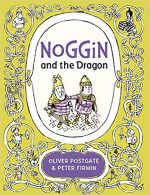
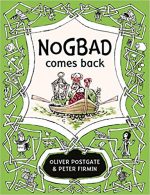
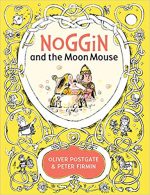
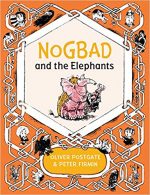
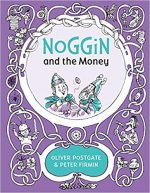
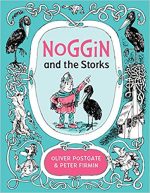
By Oliver Postgate & Peter Firmin (Egmont)
Nogbad Comes Back ISBN: 978-1- 4052-8155-3
Noggin and the Dragon ISBN: 978-1- 4052-8154-6
Nogbad and the Elephants ISBN 978-1- 4052-8142-3
Noggin and the Moon Mouse ISBN: 978-1- 4052-8141-6
Noggin and the Storks ISBN: 978-1- 4052-8144-7
Noggin and the Money ISBN: 978-1- 4052-8143-0
Win’s Christmas Gift Recommendation: Wonderful Stories By and For Human People… 10/10
Baby Boomers like me consider our childhoods – no matter how personally privileged or deprived – to have been a golden age in terms of liberty, agency and especially entertainment. That’s probably due in large part to being exposed to the gentle, life-affirming fantasy worlds of these guys.
Richard Oliver Postgate was a writer puppeteer, animator and unrepentant storyteller who was born to an extremely prestigious, overachieving and drama-drenched family. He was born April 12th 1925 in Hendon Middlesex and educated at Woodstock School, Woodhouse Secondary, Dartington Hall College and Kingston College of Art.
He joined the Home Guard in 1942 but when at last called up, declared himself a Conscious Objector – just as his father did during the Great War. Court martialled and sentenced to Feltham Prison, he eventually became a land-worker growing crops. After the war Postgate worked for the Red Cross in Occupied Germany. He returned to Britain in 1948, went to Drama School and drifted from job to job.
In 1957, whilst working as a stage manager for ITV company Associated Rediffusion, he observed the appalling quality of children’s programming up close and knew he could do better for the same paltry money offered. He wrote Alexander the Mouse and convinced a Central School of Art tutor named Peter Firmin to draw the backgrounds for him.
After moving on to short-lived deaf-viewer project The Journey of Master Ho, in 1959 the creators formalised their partnership as independent studio Smallfilms. The rest is history…
When not shaping the minds of 30-years-worth of kids, Postgate continued trying to save and refine mankind. He was active in the CND movement and wrote their pamphlet The Writing on the Sky and 1981 book Thinking it Through: The Plain Man’s Guide to the Bomb.
In 1986, he created a 15-meter artwork for his latterday romantic partner Naomi Linnell’s book Illumination of the Life and Death of Thomas Beckett, repeating the exercise for the Triumphant Failure (about Christopher Columbus) and triptych A Canterbury Chronicle. You can see them if you visit the city’s Royal Museum Art Gallery and Eliot College Campus…
Working when he pleased, Postgate narrated – in that calm quiet compelling voice hardwired into the brains of millions – radio comedy and documentary shows, wrote more books such as autobiography Seeing Things, and accompanied his greatest creation Bagpuss (voted in 1999 the Most Popular Children’s Television Programme of All Time) as the stuffed cat accrued awards such as an honorary degree from the University of Kent at Canterbury.
He died – hopefully properly and rightly well-contented – in Broadstairs Kent, on December 8th 2008.
Peter Arthur Firmin was born in Harwich on 11th December 1928. Following training at Colchester School of Art and National Service in the Royal Navy, he attended Central School of Art and Design in London from 1949 to 1952. A creative man of many talents and disciplines, he then worked as a stained-glass designer, jobbing illustrator and lecturer.
Whilst teaching at Central in 1957 he was targeted by audacious, up-and-coming children’s TV writer Oliver Postgate who believed (quite rightly) that clever individuals could produce high-quality kids’ viewing at reasonable cost.
After producing backgrounds for Postgate’s Alexander the Mouse and The Journey of Master Ho, Firmin became equal partner in new venture Smallfilms, which grew in a shed at the artist’s Canterbury home. The kindred spirits initially produced hand-drawn cartoons and eventually stop motion animation episodes for series including Ivor the Engine, Pingwings, The Saga of Noggin the Nog, Pogle’s Wood/The Pogles, Bagpuss and The Clangers.
Postgate wrote, voiced and filmed whilst Firmin drew, painted, built sets and made puppets. Their spouses and friends were often dragooned if they showed useful talents such as sewing or knitting…
During those early days Firmin seemed tireless. In addition to the Smallfilms job he also devised, designed and populated other kids shows such as The Musical Box and Smalltime. In 1962 with Ivan Owen he created a fox puppet for The Three Scampies. That creation soon had his own show and career as Basil Brush…
Throughout his life, Firmin continued his cartooning and illustration career. This included writing and/or illustrating a number of books such as Basil Brush Goes Flying, The Winter Diary of a Country Rat, Nina’s Machines and Postgate’s Seeing Things – An Autobiography.
Firmin also worked as a printmaker and engraver, designer and educator. In 1994 he was asked to create a British postage stamp and produced a magnificent offering featuring Noggin and the Ice Dragon.
Even at their most productive and overworked, Postgate & Firmin always ensured there was plenty of ancillary product such as Christmas Annuals, comic strips, spin-off books, games and puzzles for their devoted young fans. One of the most charming and enduring was a series of “Starting-to-Read†books released by Kaye & Ward between 1965 and 1973. Postgate & Firmin crafted all 8 books in a kid-friendly format gently sharing the further adventures of the Nicest Norseman of Them All…
Available again in superb hardcover editions – perfect for tiny hands – the first two (Noggin the King and Noggin and the Whale, both originally released in 1965) were reviewed here; a brace of charming, gently humorous escapades starring the TV cast and beautifully illustrated in a variety of duo-toned line-&-colour with wit and subtle charm by the irrepressible Firmin. Now with the gift-giving season in full swing let’s tempt you with the splendid rest…
On the death of his father, quiet, unassuming Noggin becomes king of the northland Viking tribe known as the Nogs. He rules with understanding and wisdom – generally thanks to his advisors: wife Nooka – who hails from the far north (we’d call her an Inuit or Inuuk princess these days) – bluff old codger Thor Nogson and talking green cormorant Graculus.
Despite many fantastic adventures, Noggin prefers a quiet home life with his people and his boisterous son Knut…
Originally released in 1966, Noggin and the Dragon sees little Prince Knut and his chums pestering the royal couple to let them go on a dragon hunt. Noggin and Nooka are reluctant at first – Dragon Valley is no place for little boys and besides, the best thing to do with dragons is give them sweets and make friends – but eventually the proud parents capitulate to pester power.
To ensure things go smoothly they insist old warrior Thor Nogson goes with them, but as the unruly boys trek out into a gathering storm, no one has any idea regarding the shocking surprise in store for them all…
From the same year, Nogbad Comes Back highlights the return from exile of Noggin’s wicked usurping uncle, just in time to try and spoil the King’s annual animal and vegetable show. Living up to his name, Nogbad the Bad tries to win the glittering jewel-encrusted cup for best flora and fauna by devious cheating and, when that fails, through simple shameful theft.
Luckily, Nooka is not as forgiving and kind as her husband and has been keeping a close eye on her outlaw in-law…
The next year saw two more books: one of which was a distant precursor to one of Smallfilms’ most successful franchise creations…
Noggin and the Moon Mouse begins with Knut enacting an official ceremony at a water trough. The proceedings are utterly disrupted when a strange silver ball crashes down and a child-sized rodent-like creature emerges. Caught up in the excitement, the prince and his unruly pals give chase until Queen Nooka takes charge. After admonishing the boys, she and Noggin befriend the strange visitor (who actually comes from another world) and help him gather the odd household items he requires to return to the stars…
And yes, a few years later a peculiar band of woolly beasties began communicating with us all in their universally comprehensible penny-whistle pipings in a little show called The Clangers…
Nogbad and the Elephants proves that there are many perks to being royal. One is wonderful presents such as the gigantic gem-encrusted, long-nosed big-eared beast presented to Prince Knut by the King of Southland. Sadly, the wonderful creature is constantly unhappy and falls under the sway of crafty Nogbad who lures it away to steal its jewelled coat. Realising it’s been hoodwinked, the piteous pachyderm takes restorative action in its own unique manner, compelling Knut to make his first grown-up decision…
The last brace of tales comes from 1973, and begins with the hilarious Noggin and the Money wherein Court Inventor Olaf the Lofty suffers a setback in his dream to modernise the nation. The Nogs have been happily soldiering on using barter and trade as long as anyone can remember, so when the big thinker creates coins as currency, he thinks he’s made life easier for everybody. Thor Nogson soon learns to disagree after he’s despatched to acquire eggs for the royal breakfast and meets rather a lot of resistance to the new-fangled nonsense…
Wrapping up the fun is Noggin and the Storks which finds the King sagely dealing with a minor ecological crisis. Sooty Storks have nested on the chimneys of the town for decades, using the heat of cooking fires to warm their eggs. This year, as the birds are particularly numerous, the populace are continually being smoked out of their own homes.
Angrily, they petition Noggin to let them chase the pests away, but as king of birds as well as people, the smooth sovereign seeks another, more equitable solution. Cue Olaf the Lofty, who has an idea involving an old chalk quarry, a stand of hollow trees, masses of convoluted piping, steel sheets and tons of firewood….
Serenely bewitching, engaging and endlessly rewarding (both these books and their much-missed, multi-talented originators) the works of Postgate and Firmin shaped generations of children and parents. If you aren’t among them, do yourself a great favour and track down those DVD box sets, haunt the streaming services and buy these books. You won’t regret it for an instant…
Text © The Estate of Oliver Postgate 1965-1973. Illustrations © Peter Firmin/The Estate of Peter Firmin 1965-1973.
